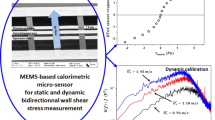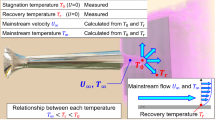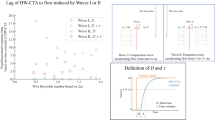Abstract
THEORETICAL studies of magnetohydrodynamic (MHD) flows in ducts and around bodies of revolution have predicted the occurrence of intense shear layers in these systems. This study is a detailed investigation of velocity profiles in such a shear layer. A miniature, quartz-insulated, cylindrical, hot-film sensor (0.03 mm in diameter and sensitive length of 0.50 mm, supplied by Thermo-Systems Inc., St Paul, Minnesota) is used in the constant-temperature mode in mercury; this device shows much promise as a velocity indicator in electrically conducting media. I have already discussed the application of hot-film anemometry to low speed mercury flows (0–15 cm/s)1,2, and higher speed applications have been discussed by Hoff3.
Similar content being viewed by others
References
Malcolm, D. G., J. Fluid Mech., 37, 701 (1969).
Malcolm, D. G., DISA Information (in the press).
Hoff, M., Instruments and Control Systems, 42, 3, 83 (1969).
Hunt, J. C. R., and Malcolm, D. G., J. Fluid Mech., 33, 775 (1968).
Hunt, J. C. R., and Stewartson, K., J. Fluid Mech., 38, 225 (1969).
Author information
Authors and Affiliations
Rights and permissions
About this article
Cite this article
MALCOLM, D. Investigation of a Steady Magnetohydrodynamic Shear Layer using Hot-film Anemometry. Nature 224, 909–910 (1969). https://doi.org/10.1038/224909a0
Received:
Revised:
Issue Date:
DOI: https://doi.org/10.1038/224909a0
- Springer Nature Limited





